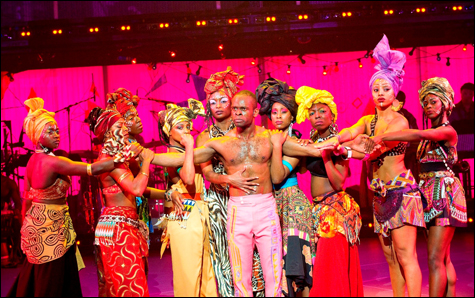
ACTION! Even if you don’t feel you’re actually there, you might want to jump to your feet anyway. |
The success of the Metropolitan Opera's "Live in HD" experiment augurs well for dance on the big screen. Simulcast at select theaters, with tickets priced higher than for a movie but much cheaper than for a live opera, these events generate a sense of anticipation. They're worth taking off your slippers for and going out. Now that the opera series has caught on, the National Theater of Britain is offering several dramatic productions. Even ballet is getting on board.
Last week's presentation of the National's Fela! might be a first step. "Live" is a relative term here, since the London showings were tape-delayed to move the performance to the evening our time, and the event will screen again at the Coolidge Corner Theatre this Monday evening (January 17). But shooting a performance as it takes place, without editing and with a live audience, seems to promise more immediacy than something that's pre-recorded in a studio.
Choreographed and directed by Bill T. Jones, Fela! is a skillful blend of dance, music, media, and talk. The show, which collected three Tonys, has just closed after a year on Broadway. The production is built around the life of the Nigerian Afrobeat musician and political activist Fela Anikulapo-Kuti, as told by his character, the actor Sahr Ngaujah. The script, by Jones and Jim Lewis, begins as Fela is planning to leave Nigeria after incurring the wrath of the military government. When his mother is murdered by the police, he experiences a religious vision and decides his role is to stay and continue the fight.
We learn a lot about Fela's musical journey, and we get glimpses of the post-colonial African situation, but there's not much about his own flamboyant lifestyle, or his death in 1997 from AIDS. In an intermission interview, Bill T. Jones admitted he thinks of Fela as a "sacred monster." But the show portrays him as a culture hero.
Live dance, especially ballet and contemporary dance, is still resistant to decent filming. As the National Theatre's media producer, David Sabel, told the Boston Herald last week, "The track record of filmed stage performance is really bad. It looks stagey, with awkward camera positions. It takes away what makes the art form special."
To compensate, if not re-create, what makes the art form special, the National Theatre's nine cameras get right into the audience; they're placed all over the theater, with surround-sound coming at us from our own theater. To do this, you have to inconvenience the live audience to some extent — cameras were sticking up from the orchestra pit and out of the wings, for instance, and frequently they were aimed at the audience instead of the actors. This didn't make me feel I was there, though when Fela got the audience up on its feet to try some pelvic gyrations, I wanted to join in. No one else at Rockport's Shalin Liu Performance Center leapt up, though, so I didn't either.